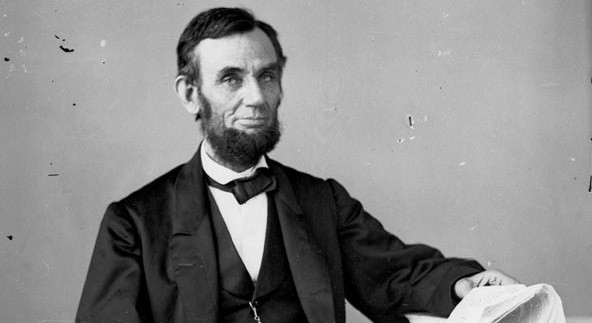
On December 31, 1862, President Lincoln confers with his Cabinet on the final wording of his Emancipation Proclamation, and signs into law an act establishing West Virginia as the nation’s 35th state. Photo from Library of Congress
December 21, 1862 – January 10, 1862
By Phil Kohn
Phil Kohn can be reached at USCW160@yahoo.com
The massive Union raiding force of Brig. Gen. John Foster returns to its base at New Bern, North Carolina, on December 21, 1862, after destroying a key railroad bridge at Goldsboro. Meanwhile, Confederate Col. John Hunt Morgan and his cavalry depart Tennessee to embark on a “Christmas raid” into Kentucky against Federal supply lines.
In Washington, D.C., after conferring with Maj. Gen. Ambrose Burnside, President Lincoln on December 22 issues an order congratulating the Army of the Potomac for its bravery at Fredericksburg, Virginia.
In Richmond, on December 23, Confederate President Davis declares U.S. Maj. Gen. Benjamin Butler a felon, an outlaw and “an enemy of mankind.” The declaration is spurred by the intensity of New Orleans residents’ bitter feelings towards Butler because of his tyrannical military governorship of the city. Davis states that Butler should be immediately executed if captured and that any Federal army officers captured and imprisoned should not be released prior to Butler’s punishment.
On Dec. 24, U.S. Army units arrive to reinforce naval forces that had previously captured Galveston, Texas, situated on the coast of the Gulf of Mexico.
In Mankato, Minnesota, on December 26, 38 Santee Sioux are hung for their roles in the uprising of August-September 1862, in which between 450 and 600 settlers were killed. Ordered by President Lincoln, who reviewed each case, the hangings are the largest mass execution in the history of the United States. Having come ashore north of Vicksburg, Mississippi, Maj. Gen. Sherman’s force of 32,000 begins moving towards the city. Advance units begin clashing with Confederate outposts. In concert with Sherman’s soldiers, Federal gunboats begin firing on Confederate shore batteries. In Tennessee, Federal troops led by Maj. Gen. William Rosecrans leave Nashville and move towards Gen. Bragg’s Confederates near Murfreesboro.
Col. John Hunt Morgan’s 2,500 Confederate cavalrymen on December 27 force the Federal garrison at Elizabethtown, Kentucky, to surrender. Union troops, entering the Indian Territory from Arkansas, capture and burn Ft. Davis, situated below the Arkansas River in the Cherokee Nation. The Federals soon withdraw.
Maj. Gen. John Schofield’s Union cavalry, along with Federal infantry under Maj. Gen. James Blunt, attacks Van Buren, Arkansas, on December 28, 1862. The Federals seize 100 prisoners, as well as equipment and supplies.
On December 29, 15,000 Confederates rebuff Sherman’s force of 32,000 at Chickasaw Bluffs, Mississippi, north of Vicksburg. The Union troops try several times to break through the Southerners’ lines, but to no avail.
Shortly after midnight on December 30, in stormy waters off Cape Hatteras, North Carolina, USS Monitor founders and sinks with the loss of 16 officers and men. The nearby USS Rhode Island rescues 47 other members of Monitor’s crew.
The last day of 1862 — December 31 — is extremely eventful. President Lincoln confers with his Cabinet on the final wording of his Emancipation Proclamation, and signs into law an act establishing West Virginia as the nation’s 35th state. In Tennessee, Maj. Gen. William Rosecrans launches 47,000 Federal troops against 37,000 Confederates led by Gen. Braxton Bragg at Stones River, near Murfreesboro. Both commanders plan to attack the other’s right, but Bragg moves first and crushes the Federal line. A desperate counterattack, led by Brig. Gen. Philip Sheridan, saves the day for the Union. Both sides remain on the field, waiting to resume fighting the next day. The cavalry of Brig. Gen. Nathan Bedford Forrest meets Union troops at Parker’s Cross Roads, Tennessee (near Clarksville), and forces the Federals back a half mile. While Forrest is requesting an unconditional surrender from the Union commander, his force is surprised by an attack to its rear by a newly arrived Federal brigade. Caught between the two Union forces, front and rear, Forrest orders his troopers to “charge ’em both ways.” Forrest’s troops do so and fight their way out, but lose 500 men, one gun and all the goods captured along the way. Both sides claim victory. Along the Mississippi River, Sherman’s force, still trying to push through to Vicksburg, once again clashes with Confederates, this time at Haines Bluff, Mississippi. The Southerners hold strong, forcing a Union withdrawal. Federal casualties: 1,776; Confederate: 207. Maj. Gen. Sherman says later: “I reached Vicksburg at the time appointed, landed, assaulted and failed.”
As of January 1, 1863, troop strengths stand at roughly 920,000 for the United States and around 450,000 for the Confederate States. In Texas, Brig. Gen. John Magruder, with troops and improvised gunboats, re-captures Galveston for the Confederacy. Near Murfreesboro, Tennessee, both sides stand ready to resume fighting at Stones River, but their commanders — Rosecrans (U.S.) and Bragg (C.S.) — use the day to shift troops around. In Washington, President Lincoln issues the Emancipation Proclamation, freeing slaves in areas still in rebellion. The decree also lets them join the army. In Mississippi, Maj. Gen. William Sherman prepares to withdraw his Union troops from the area north of Vicksburg.
In Tennessee, the second day of combat at Stones River takes place on January 2, with attacking Confederate troops under Maj. Gen. (and former U.S. Vice President) John C. Breckinridge beaten back. Once again, fighting comes to a halt with both sides waiting for the other to make a move. A discouraged Confederate veteran of the battle mirrors the frustration of both sides when he writes: “I am sick and tired of this war, and, I can see no prospects of having peace for a long time to come, I don’t think it will ever be stopped by fighting, the Yankees cant [sic] whip us and we can never whip them…” Casualties of the struggle near Murfreesboro, Tennessee: 12,906 Union soldiers out of 41,400 in the battle, and 11,739 Confederates out of 35,000 engaged.
On January 3, despite holding a good position on the battlefield, Gen. Bragg, to the dismay of his subordinate generals, orders a withdrawal to Tullahoma, Tennessee, some 31 miles south. This sets them to begin actively working against Bragg with authorities in Richmond, expressing a lack of confidence in his leadership. A Confederate attack on Moorefield, western Virginia, southwest of Winchester, is beaten back.
Political appointee Maj. Gen. John McClernand — upset that he hadn’t been named to command the assault against Vicksburg (which failed) that had been led by Maj. Gen. William T. Sherman — on January 4, begins moving 30,000 Federal troops in an unauthorized expedition up the Mississippi River. His goal: the taking of Confederate Fort Hindman at Arkansas Post, Arkansas, on the Arkansas River.
Confederate partisan raiding in Missouri resumes on January 7. Brig. Gen. John Marmaduke, with 2,300 cavalrymen, captures Ozark but is unable to make headway against Federal troops and local militia under Brig. Gen. Egbert Brown at Springfield.
On January 9, the (Confederate) Missouri Cavalry Brigade, under Col. Joseph Porter, takes Hartsville, about 50 miles east of Springfield. In the Florida Panhandle, Federal sailors raid and damage a Confederate salt works at St. Joseph, on the shore of the Gulf of Mexico, roughly midway between Tallahassee and Pensacola.
On January 10, Maj. Gen. Ulysses S. Grant arrives in Memphis after pulling back from Grenada, Mississippi, following the Confederates’ destruction of his supply depot at Holly Springs. Of necessity, his force of 103,000 troops has had to live off the land, and it is an eye-opening revelation to Grant that it can be done. In Washington, D.C., a court-martial sentences Maj. Gen. Fitz-John Porter to dismissal from the army for failure to follow orders at the Battle of Second Manassas in August 1862. (Porter spends years trying to clear his name. Finally, in 1879, after a review of the circumstances, the sentence is overturned. However, it takes seven more years, until 1886, for Porter to be recommissioned as a colonel, but with back-pay denied. Two days later, he resigns from the army.) In Arkansas, Confederate Fort Hindman, at Arkansas Post, is surrounded by the Federal force of Maj. Gen. John McClernand







